Believe it or not, we’ve lived in our new house for over six months now. Half a year! So we thought this would be a good time to check in on some of the goals we had for moving and downsizing to see what has met and exceeded our expectations – along with detailing some of the biggest challenges we’ve encountered along the way.
This is going to be long & detailed, because it feels like there’s a lot of ground to cover, and while this rundown will be pretty specific to our situation, I think it’ll still give you a good window into the realities of downsizing that you might also encounter if you were to go for it. And yes, it includes money details. And a chart. You know I love charts.
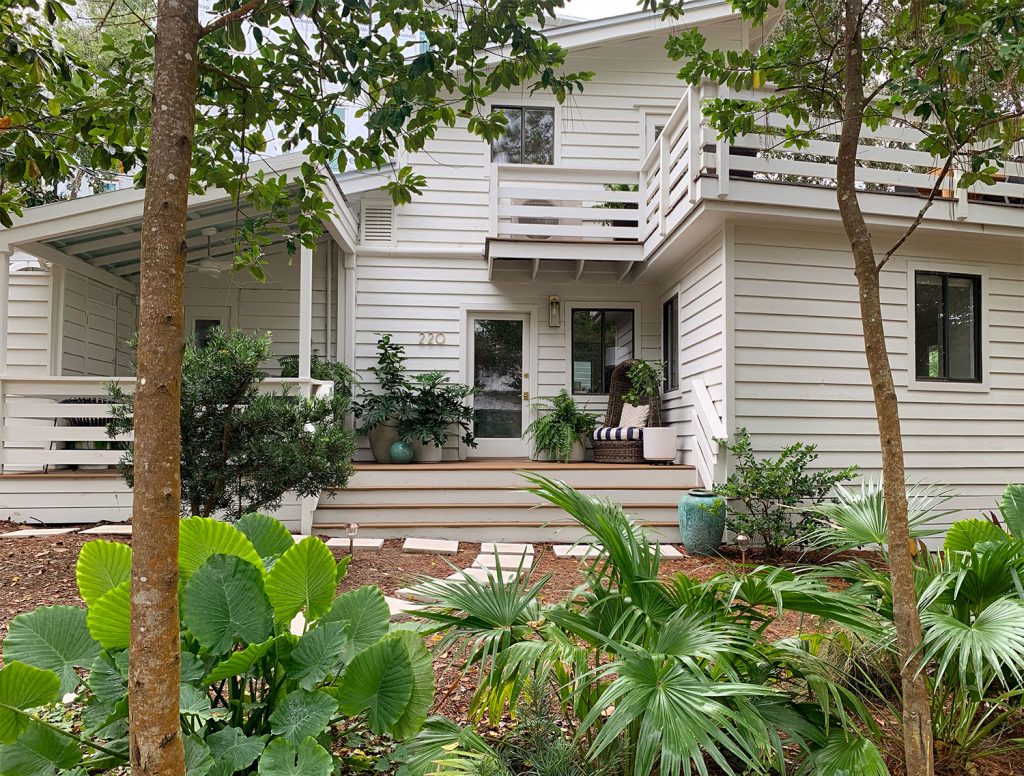
To Recap, Why Did We Move?
We’ve got a thorough explanation of our reasons for moving from Virginia to Florida in this post from February. But the gist, as we said back then, was that we wanted to “live with less and be outside more.”
For years we’ve been working towards paring down and owning less stuff (so many podcast eps about that!) and all of the apparent perks of downsizing really appealed to us, like spending less money on things you don’t need (and less money heating & cooling a space you don’t use). Devoting less time to cleaning, organizing, & maintaining a house and those aforementioned surplus belongings is also something that really sounded good to us (as people who have probably devoted 20 solid days of our lives to “cleaning up the garage” over the last 15 years).
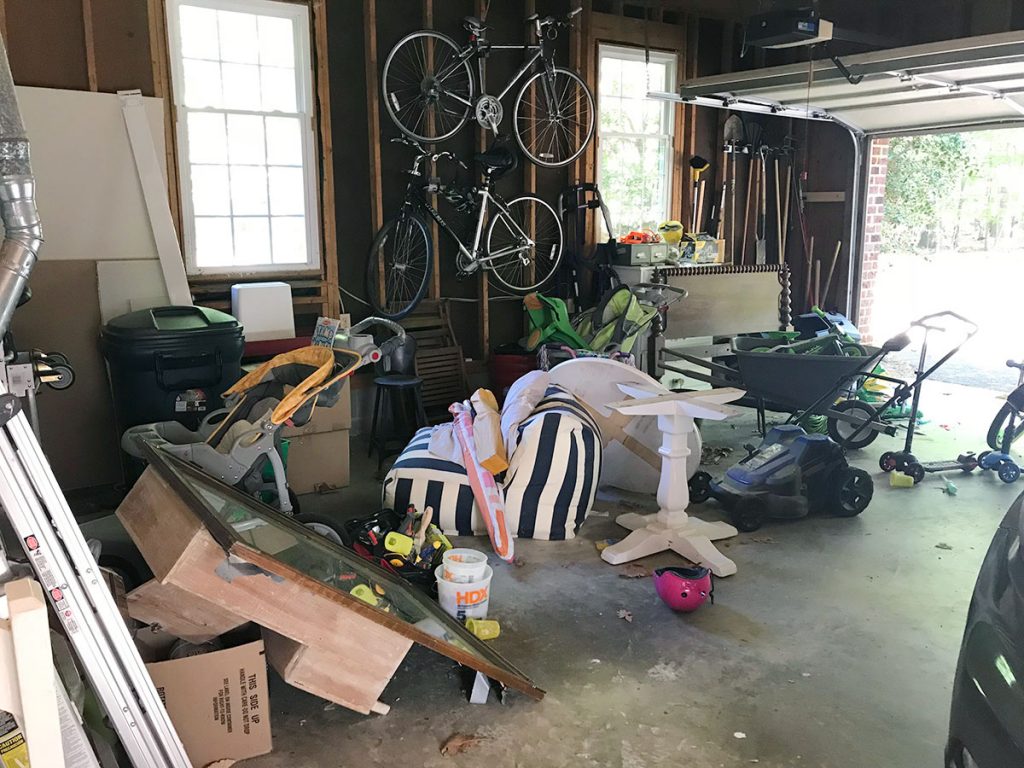
Not only did we downsize from our 3,150 square foot home in Richmond, VA to this 1,400 square foot home in Florida, but we also sold our beach house and duplex rental properties in Cape Charles, VA – basically going from 4 larger homes (because the duplex was technically two adjoined homes) down to 1 much smaller home.
As a reminder, not only was our last house more than twice as big as our current home, it also had 14 rooms (our new home has 6), and around 10 closets (our new home has 2.5 thanks to one that has our HVAC system taking up nearly half of it). Not included in that 14-room total, our last home also had a full-sized walk-up attic (that’s just Sherry’s old “basket section” pictured below)…
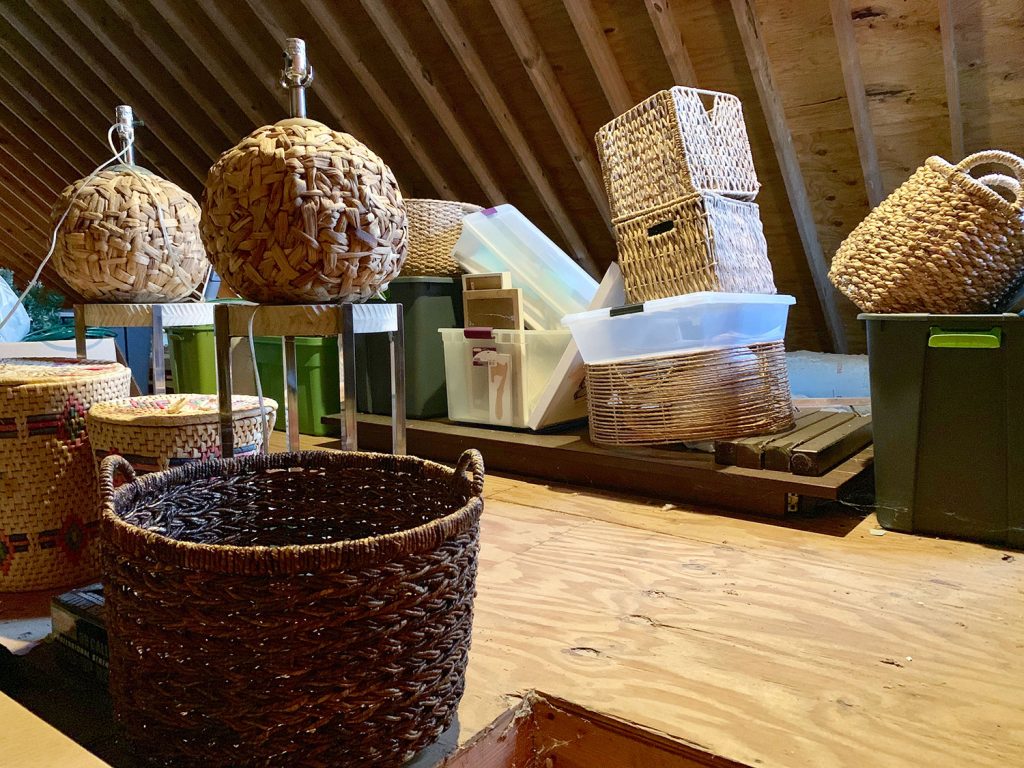
… as well as a large shed and a spacious two-car garage that at one point were all full of items – many of which we rarely and sometimes never touched (except to finally donate them in the later stages of our downsizing journey).
Obviously, we could’ve downsized without relocating to a whole new state. But to achieve that “be outside more” part of our goal, we wanted our one smaller house to also be in a warmer location. Ideally, one that was close to a beach, and generally more walkable to shops/restaurants/parks, etc. That’s why we landed on Florida (after many spring break trips there, as well as a trip to Costa Rica which led to our kids heavily campaigning to move there because they love the beach & warm weather as much as we do). Again, there’s more detail in this post about our big decision to move if you want it.
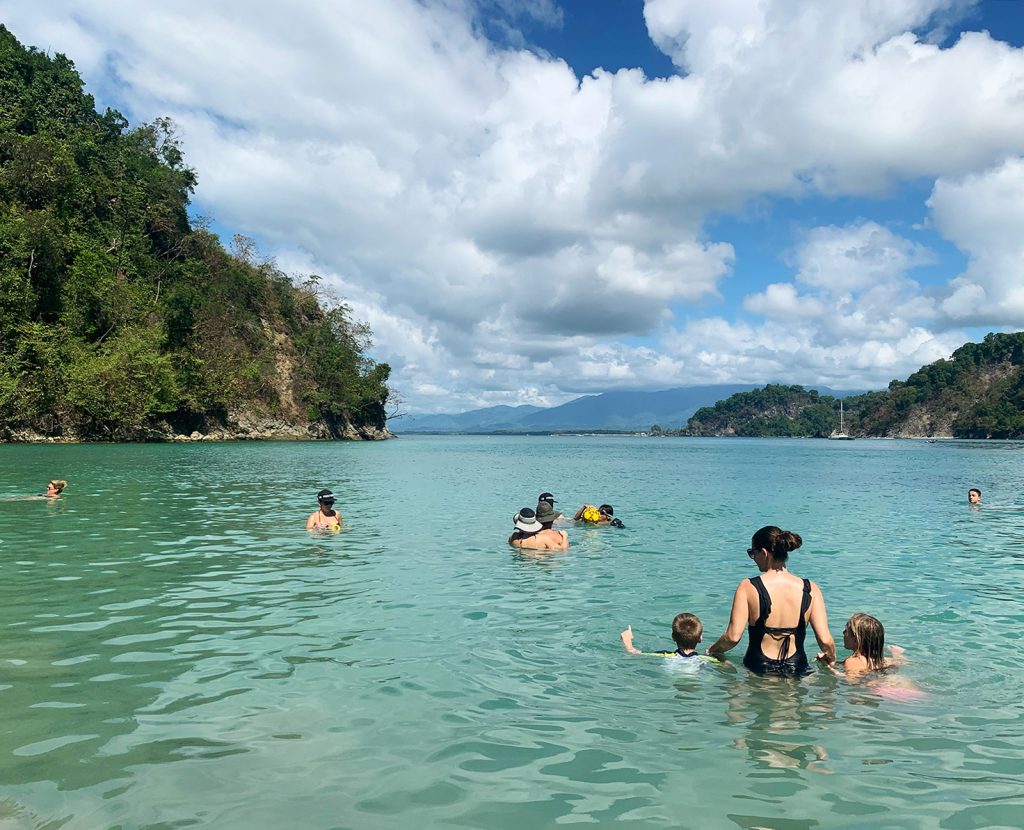
Spoiler alert: when it comes to our goal of “living with less and being outside more,” we’ve checked off both of those boxes, and we see daily reminders that this move was such a great choice for our family. Which makes us extremely grateful. Nothing was easy about this big life change (paring down so much almost feels like training for an Olympic event, it’s extremely physical work but also a ton of mental work – and we did it in the middle of a global pandemic). But it’s has been SO WORTH IT.
We’re grateful to wake up here every day (all of us, including the kids are known to say “I still can’t believe we live here!”). And Burger might be the happiest dog in the world, due to an extreme love of laying in the sun and attempting (but never even coming close to succeeding) to catch lizards. What’s that they say? The thrill of the hunt?
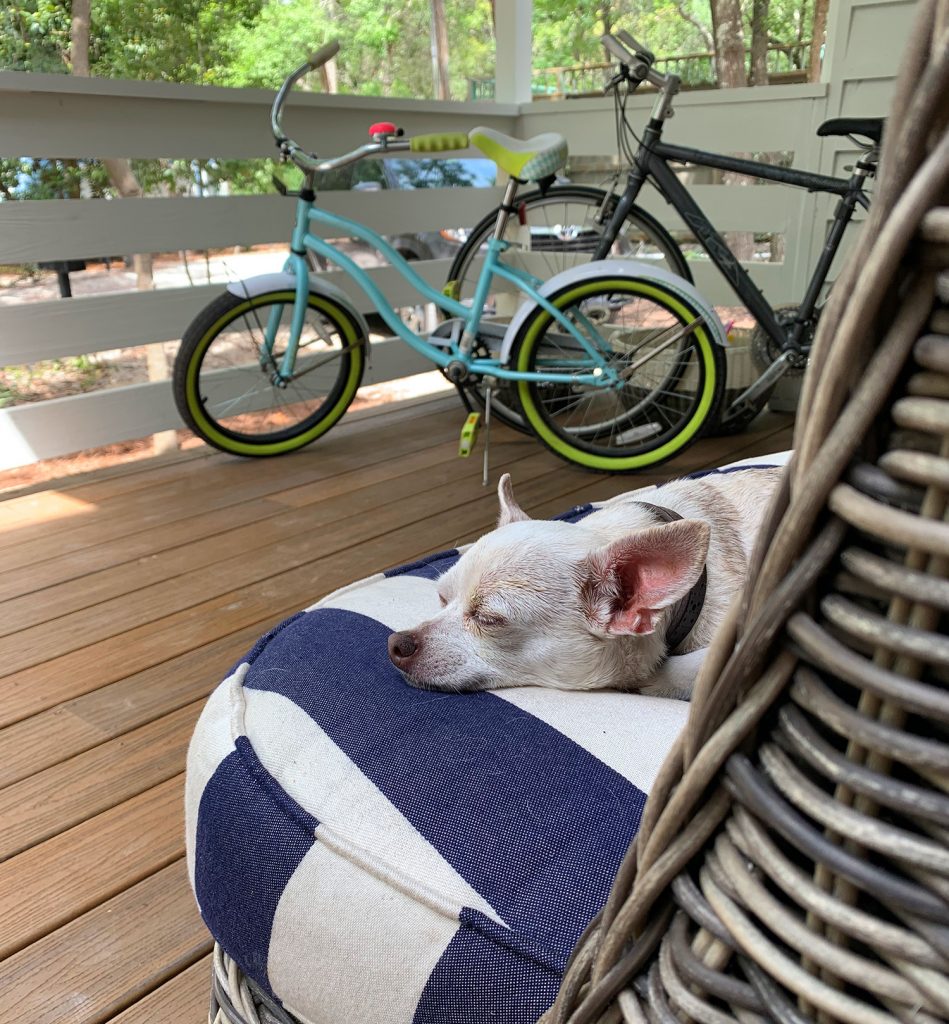
So it’s safe to say that we all really love the change and are so thankful that we went for it. But I can’t stress enough that there was nothing easy about making this big life change to get to this point (our current satisfaction meant SO MUCH WORK leading up to that), so we must have really wanted this big change in order to do all of the things it entailed! Including fitting all of our worldly possessions into one 16′ pod that we sent down to our new house in Florida.
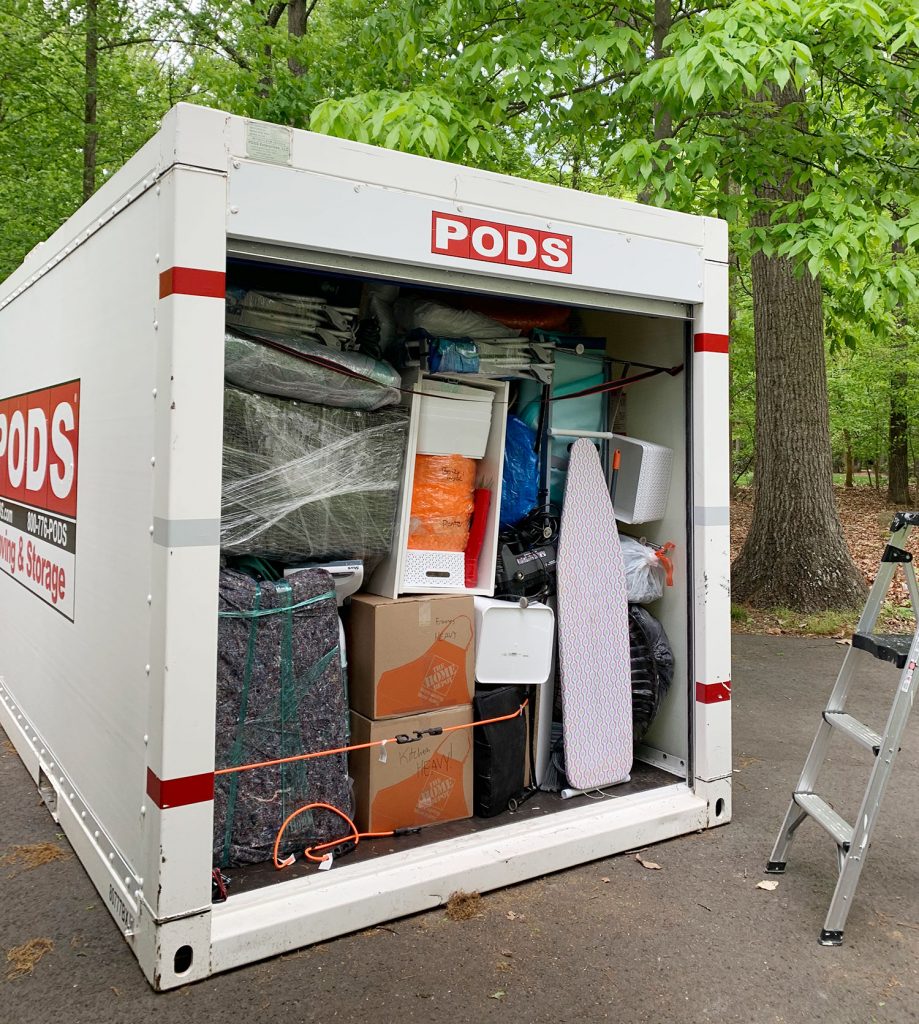
In other words, I don’t think many people blink their eyes and find themselves majorly downsized and living with less – it felt like a really huge life pivot to us, that took a lot of intentional (and hard) work. So if you’re there in that not-fun zone right now, I’m here to tell you, when we came out on the other side, it felt amazing and still does. The novelty hasn’t worn off in half a year, and might not wear off ever. Worth all the effort and then some.
If you’re reading this, and you’re like “I need specific details about what you did to downsize so much” – we have a bunch of podcasts & posts full of specific information, like:
- this podcast about exactly how we approached paring down
- this post about what we kept & what we left behind
- this podcast about one major perk of having fewer things
- this post about our much smaller kitchen storage setup
- this post about how we maximized storage in our smaller home
We also have some podcast interviews from further back with others who downsized, which majorly inspired us as well, like this one featuring Dana Miller, entitled: In Pursuit of Buying Less & Doing More and this one featuring Shavonda Gardner, entitled What’s It Really Like To Downsize?
So that’s the answer to the “how did you actually downsize?” question – now let’s dive into how living with less and being outside more over these last 6 months has actually felt (and some specific, quantifiable benefits that downsizing very clearly brought into our lives).
Having Less Space
Spending last summer in our 1,800 square foot beach house gave us lots of confidence about living full-time in a smaller home. But I’d be lying if I said the news of the pandemic (which came about a month after we made the decision to move) didn’t shake our confidence a little. We hadn’t planned on working and schooling from this smaller home. We hadn’t envisioned cooking at home more than ever in the smallest kitchen we’d ever owned. And we had planned on adding a second bathroom to this home right away (but have since decided to put that on hold, because a lot of what we assumed would be pain points in this smaller house actually weren’t!)
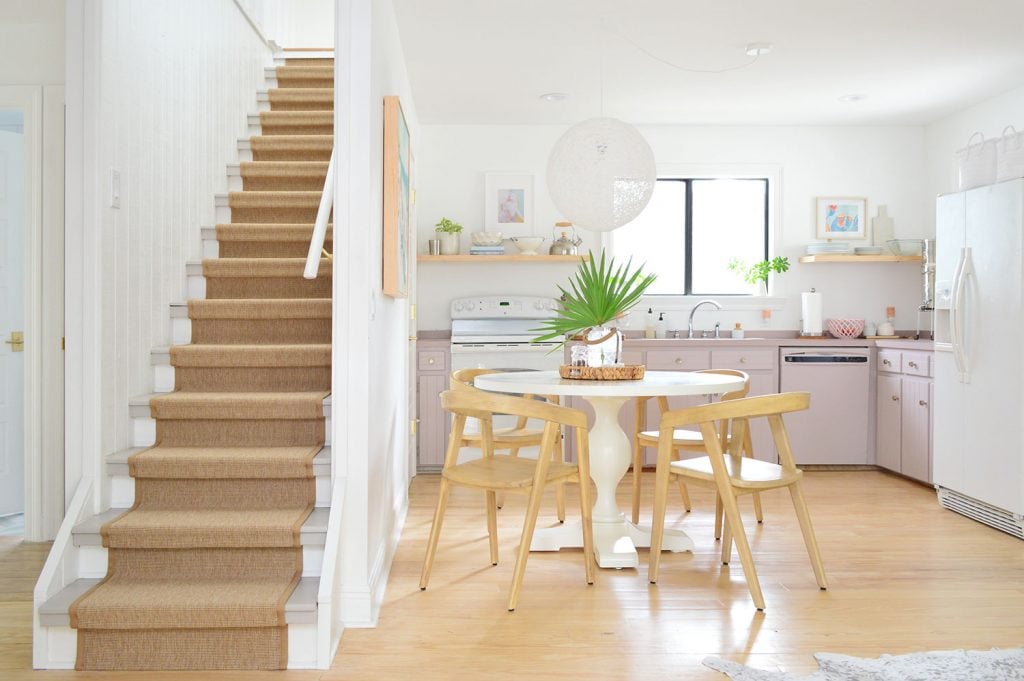
Along that theme of anticipating one thing, but actually experiencing another thing entirely… despite the curveballs, we haven’t felt the strain of living in less square footage really at all (apart from two challenges I’ll get into later in the post). What we’ve found is that as long as we’ve got a room or a spot for a particular function, it hasn’t been super important how large that room is.
For example, we may have a laundry closet instead of a laundry room now, but at the end of the day, we still have a place to do laundry. Same goes for spaces to sleep, cook, work, lounge, etc. All of our major functions are checked off here, so we don’t feel majorly impacted by having less space.
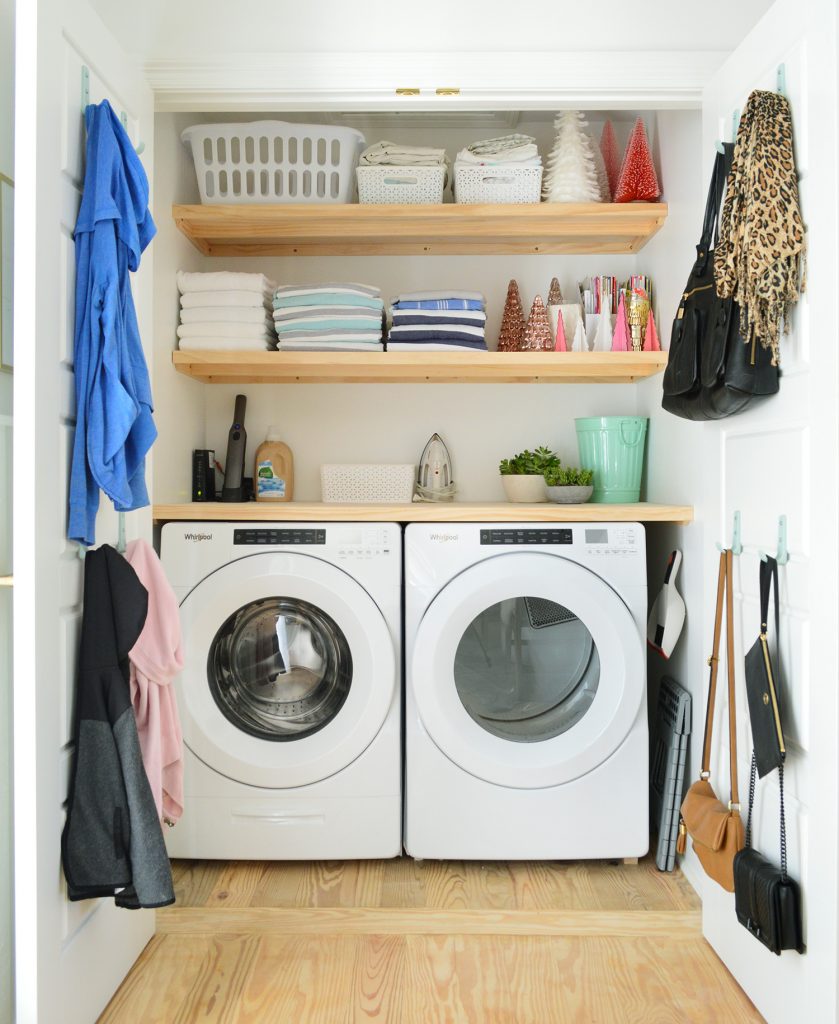
We also don’t feel nearly as “on top of one another” as we sometimes feared we might. I think a big part of this is thanks to the layout of our house, like having the family room on a separate level and having the kids’ bedrooms on the opposite end of the house from ours. We had looked at some larger houses around here that, in retrospect, would’ve been much more frustrating to live with because of their floor plan – especially with everyone in the family at home all day/every day both working and doing schooling.
For instance, a one-level house down the street from us had the bedrooms placed at each corner of a central, open living area. I think it would’ve offered little sound barrier or privacy between the TV/kitchen area and each bedroom – and if Sherry had a Zoom call for work & the kids had at-home learning going on at the same time, the sound likely would have carried from literally any space into any other.
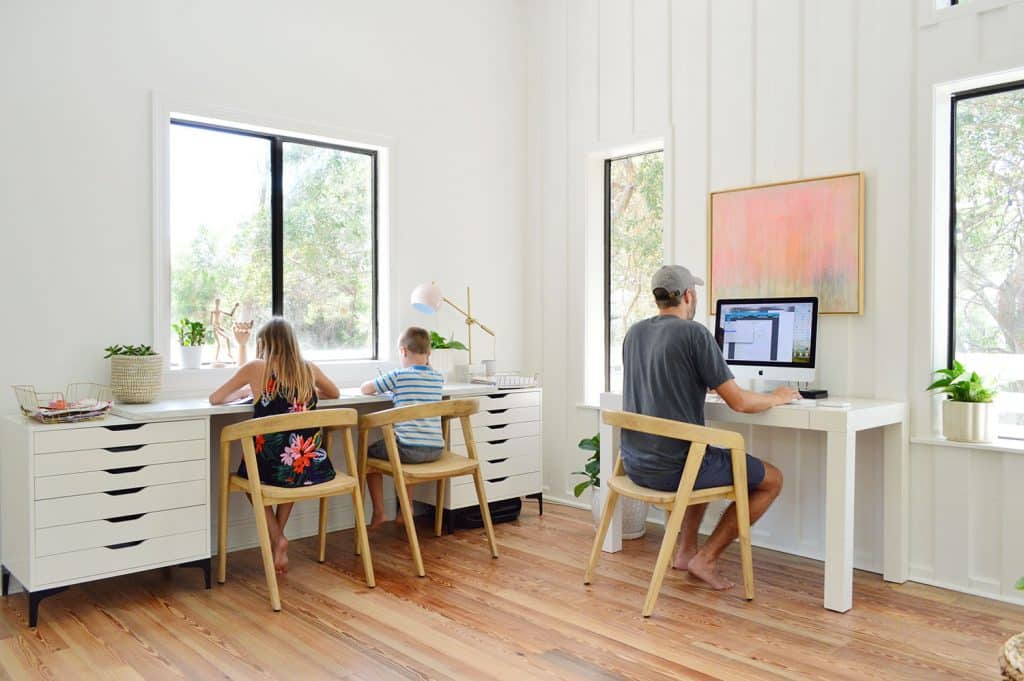
Actually we have three tips we’d offer for anyone thinking about floor planning for smaller space living. Obviously these are highly personal and it all depends on how your family will use a space, but we’ve found that these three things made all the difference for us:
Layout Tip #1: It’s great if your two largest rooms can be designated for everyone to use and share as a family (our upstairs family room is the largest, followed by our downstairs kitchen/dining/sitting area). Had we made the upstairs room into our bedroom, we would’ve been claiming the largest room in the house as our own personal spot to sleep, which just doesn’t feel efficient at all in a smaller home (our bedrooms are the smallest three rooms in the house, with the exception of the bathroom, which works really well for us).
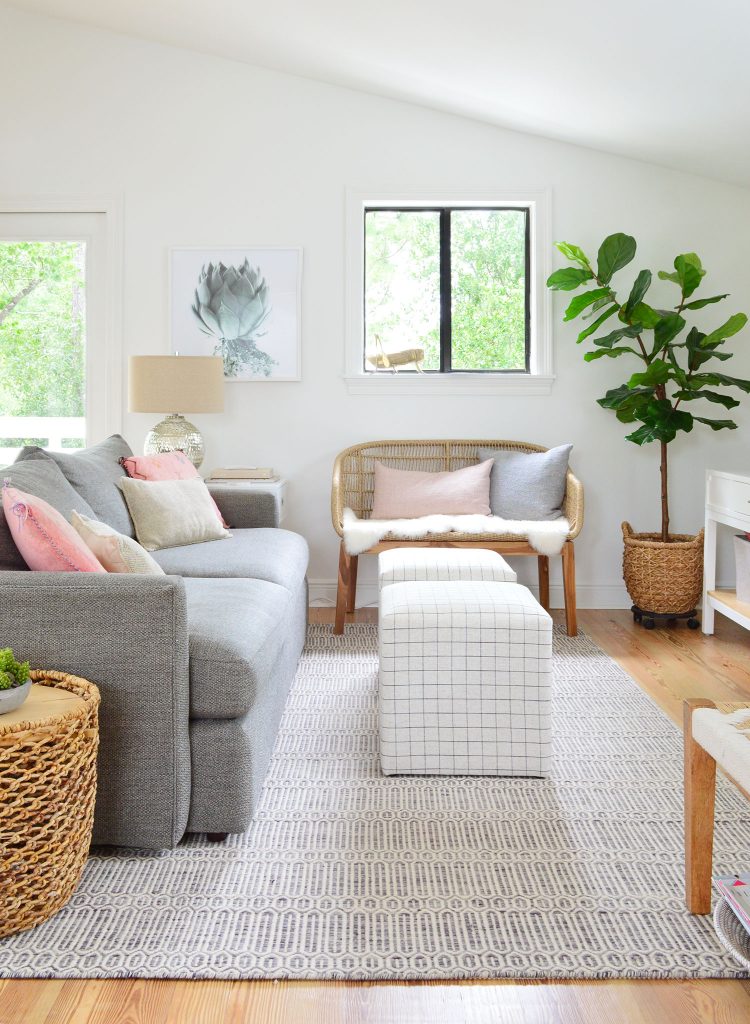
Layout Tip #2: It’s also great if those two large family spaces aren’t right next to each other. I know open-concept is all the rage, but we’ve found it invaluable that these two shared spaces are in different areas of the house because it helps us all to not feel on top of each other (and it keeps sound from carrying too much). The kids can watch TV upstairs in the family room while Sherry and I work on something downstairs, or one child can take an at-home-learning test at the kitchen table while the other works on a project upstairs at the homework/art desk (it’s key that they can’t hear or see each other, which might not have been the case if our only two “shared” family spaces were essentially conjoined).
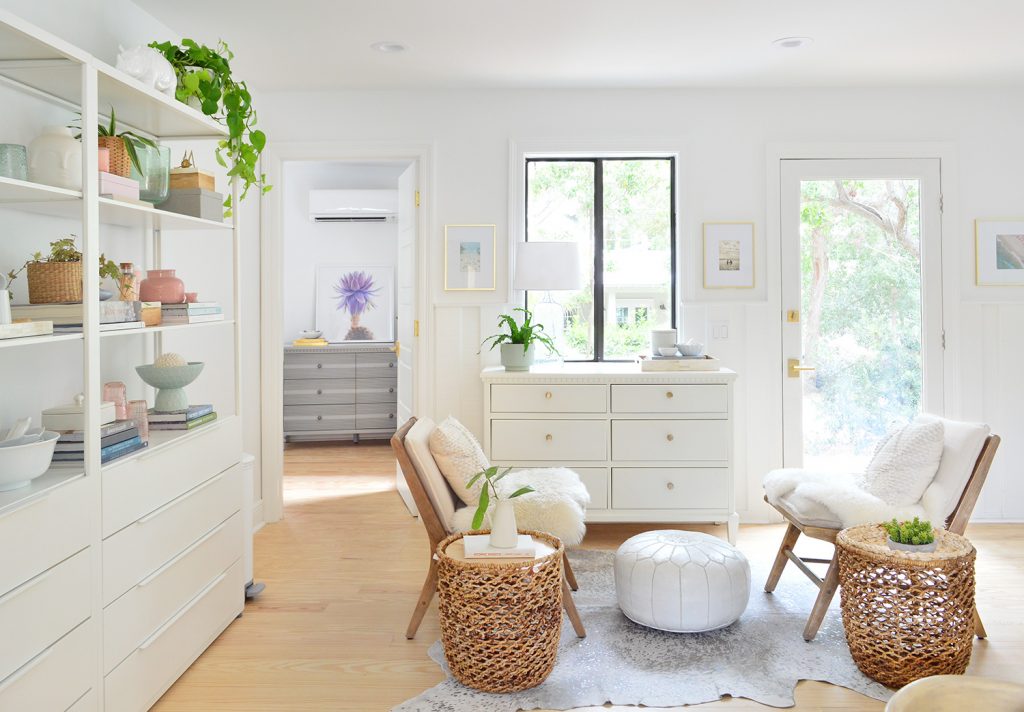
Layout Tip #3: We’ve loved having our bedroom on one side of the house while our kids bedrooms are on the other side. We’re still all sleeping on the same floor of the house (something we all wanted), but we aren’t on top of each other. Although our last house was much larger, we were a lot closer to our kids bedrooms there (all of our bedroom doors led out to the same central hallway) so it’s a nice change not to worry that we’ll wake up the kids while scream-laughing at some random TikTok video at 11pm. It’s also really nice that the kitchen/dining/sitting room is truly in the heart of the home (it’s literally in the middle), which we like a lot. We all find ourselves drawn to that space throughout the day, so it’s nice to have it centrally located.
The other thing that has helped this house feel more spacious for us is the generous amount of outdoor “rooms” that we have. Like our wide front porch and upstairs deck, which provide a ton of additional space to escape to. I often take my laptop out to the table on the upstairs deck to do some work or make some calls, and I have to tell you, I’ve never had a better office view. Speaking of the outdoors…
Spending More Time Outside
It’ll be hard to articulate what a positive change this has been to our daily lives, but I’m so glad we made being outside one of our goals with this move. We knew we were choosing a location with a climate that would encourage us to spend more time outdoors (even in November we’re getting mostly 70ºF days) but I don’t think we expected that the landscape would also draw us outside as much as it does here.
Not only do we have the beach just a few blocks away (it’s a three-minute walk), we’ve also got lots of wooded trails and paved pathways around us too – all of which give us access to parks, playgrounds, shops, restaurants, other neighborhoods, etc. So we have LOTS of good excuses to get some fresh air.
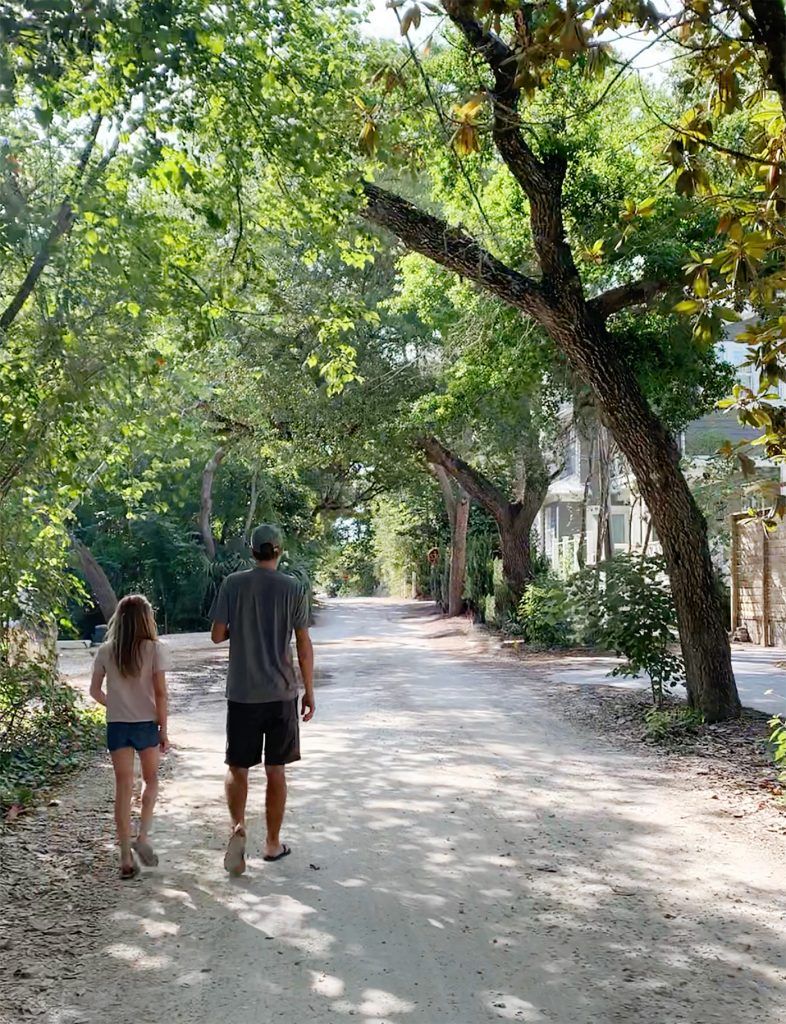
We’ve definitely incorporated so many more outdoor activities into our habits than when we lived in the suburbs of Richmond. Sherry has been able to establish a daily walking routine that includes various wooded trails and walking along the beach. I squeeze in a run, walk, or even an occasional paddleboard most early mornings. We have a weekend biking routine with the kids, and they spend just about every break between school lessons out in the yard running around or hanging out together on the tree swing. And unless it’s raining, most evenings we try to fit in some sort of family walk. And, of course, we have the beach just a few blocks away.
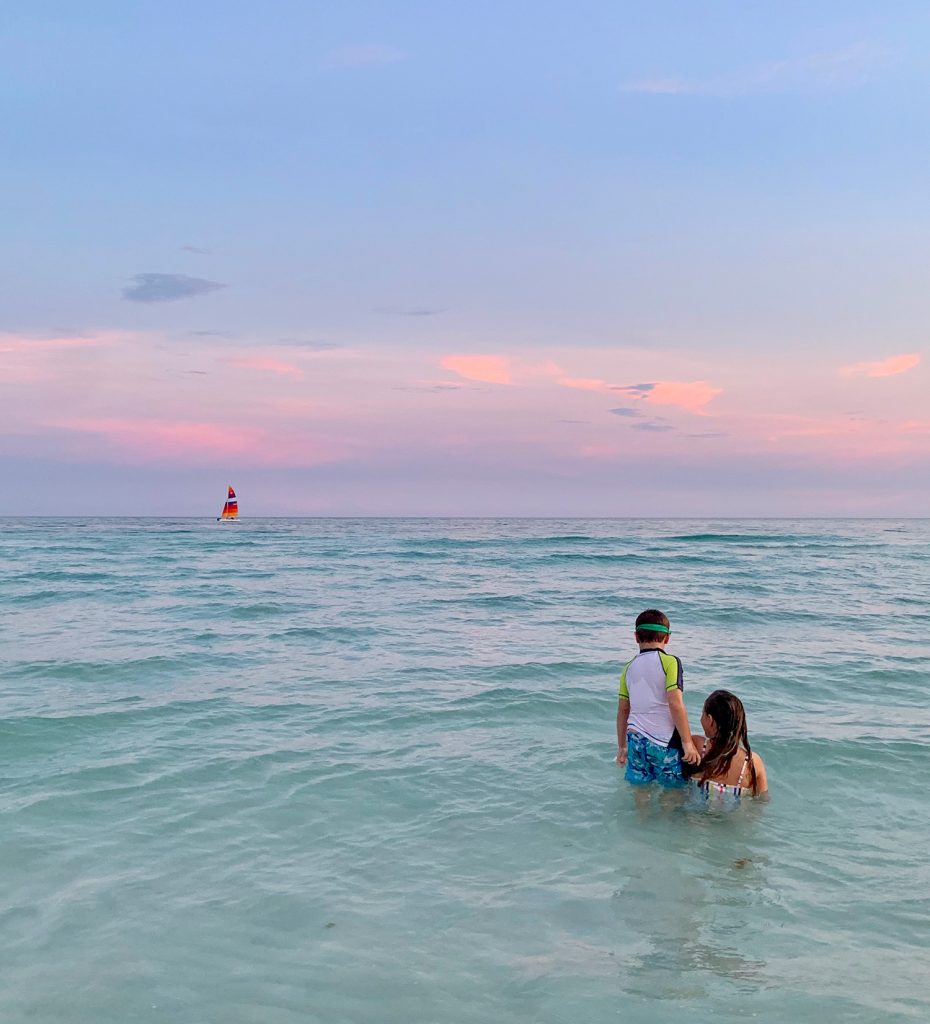
One other perk to so much outdoor living has been getting to know our neighbors and making friends with people who live near us whenever we’re out and about. Family walks have led to us meeting other families with kids the same age as our own who will all attend school together once they go back in person. We’re so grateful that even during a pandemic, thanks to having this outdoor lifestyle, we’ve been able to meet so many new people (who we can’t wait to have over for dinner when things are safer). In a year where fresh air has become even more important to our collective health and sanity, it has been so helpful.
Owning Less Stuff
We had already been enjoying the benefits (I almost said “thrill” there, ha!) of paring down and decluttering for a few years now, so we didn’t really expect any surprises, but one thing we’ve both noticed is that we don’t really lose stuff here. Like if we’re looking for a certain piece of clothing or tool or toy, we know exactly where to find it.
There are probably two reasons for this, and one is just a function of moving. Since we’ve packed, unpacked, and organized every single thing we own, our memory of where things are is pretty fresh.
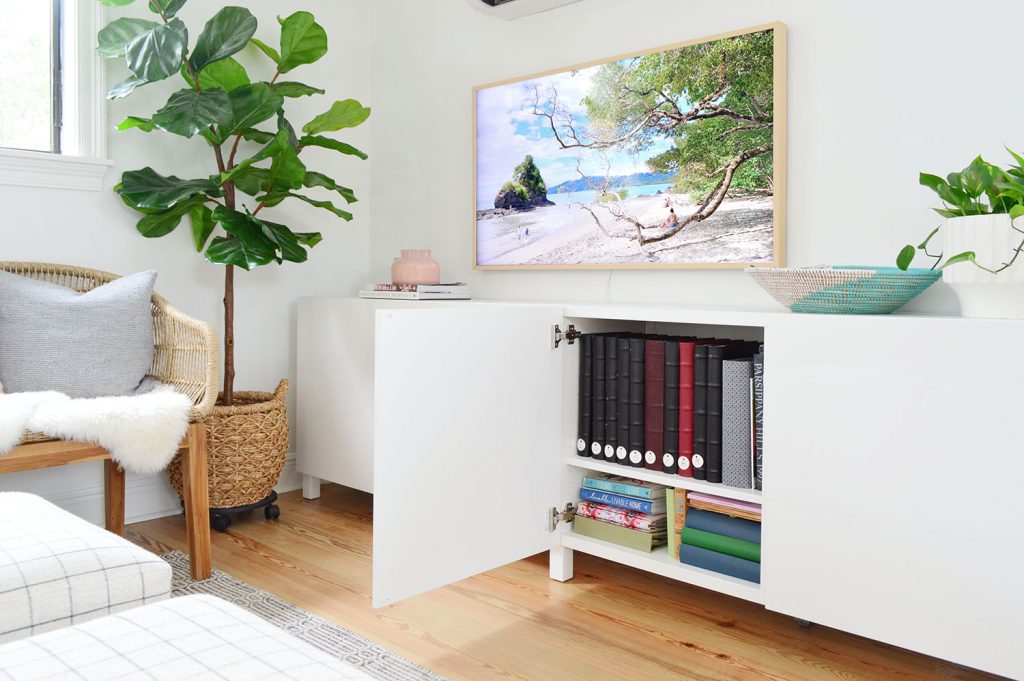
The second thing is that having less space means fewer spots that things could be and less junk to sift through when you’re hunting for something. In our last house, we had cleaning stuff upstairs in the bathrooms, but also downstairs under the kitchen sink. Here’s it’s all under the kitchen sink. In our last house, games were spread out between our bonus room, our living room, and even the kids’ rooms. Now they’re all in our family room.
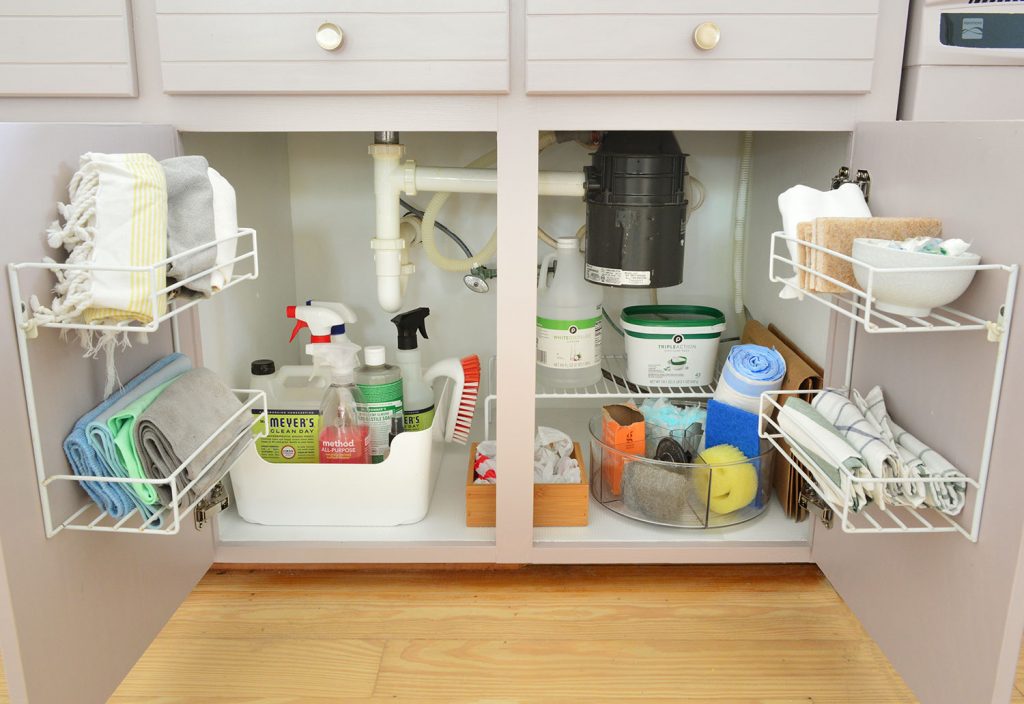
There was a reason for having things spread out in that house (sometimes you don’t want to go down to the kitchen to get the cleaning spray you need for the upstairs bathroom) but I think part of it was just a general tendency to fill the space you have. Empty bathroom cabinet? Let’s put an extra bottle of cleaner in there! That house had so many cabinets and closets (our kitchen alone had 51 cabinets, versus the 12 that we have here). So when we had those storage spaces in all corners of our house, we filled them with things. And over time it became harder to remember what was where.
Maybe we’ll be singing a different tune in a few months as time has fogged our memory of unpacking & organizing within an inch of our lives (that’s really a huge part of downsizing: finding a smart spot for everything). But for now, it certainly feels like having less space to spread things out & stash extra stuff is keeping us a lot more organized. Plus, without lots of spare space to store things, it forces us to be really thoughtful about what we’re buying and adding to our belongings.
Spending Less Money
Let’s talk money! Lots of people downsize for financial reasons, and they were certainly a factor for us too. We’ve always considered ourselves to be pretty frugal, but there were moments over the last couple of years where we didn’t feel that way. Particularly when we were in the midst of renovating the duplex, furnishing the beach house, and paying for insurance, utilities, and taxes for four different homes (remember, the duplex = two attached houses). Life suddenly felt very full of bills!
So a big part of what helped sell us both on the idea of downsizing was that we could cut down on our bills and put a stop to paying for all of this space that wasn’t being used all the time. We talked all about the big money question everyone was asking us back in May on the podcast (the money side of selling three houses and downsizing to one smaller home), but just last week I crunched some other numbers for the first time and it was kind of mind-blowing. So I wanted to talk about three other areas that we’re seeing a big difference: utilities, landscaping, and gas (like for our car).
Utilities
Let’s start with some utility bill costs because they’re some of the most obvious savings that people seek when they downsize. Keep in mind, these numbers represent going from paying to heat/cool/have lights on/have water/have internet for 7,000 square feet (across 4 houses) to all of those things in just 1,400 square feet (our current house), so they’re extra dramatic, and likely a lot more than you might see going from one house to one smaller house. This downsizing thing really made a huge quantifiable difference for us:
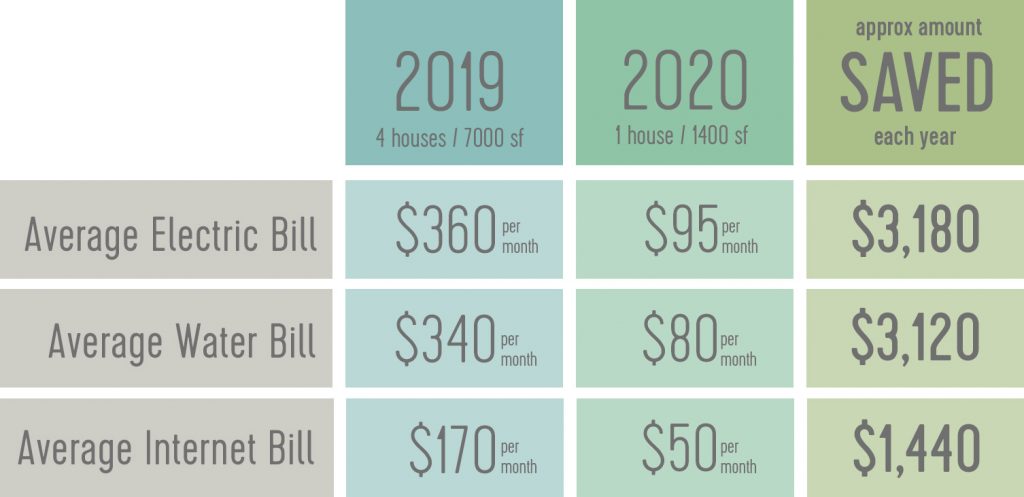
Simply put, you can see that going from 7,000 to 1,400 square feet will likely save us about $7,750 a year on just these three utility bills alone.
Landscaping
In addition to reducing our interior space, we also cut down big time on the exterior spaces that we have to maintain. Our lot in Richmond was a little under an acre of land, and we spent a whole bunch of time & money mowing, seeding, fertilizing, irrigating, mulching, & leaf-blowing it each year. We did basically all of it ourselves for many years, but over the last couple of years started hiring out certain tasks (like having someone mow it while we spent the summer in Cape Charles so it didn’t turn into a jungle).
In turn, we also had to pay someone to mow the yards at our beach house and duplex whenever we weren’t there to take care of that ourselves. Much like bills, it felt like the mowing never stopped. And the mulching, the seeding, and the leaf blowing. In fact, last year we spent about $3,750 on lawn care alone across all four houses (that also includes a few big leaf pickups along with all that mowing, and a huge delivery of mulch that we’d get annually for our various garden beds along with grass seed to reseed things ourselves in the fall, etc).
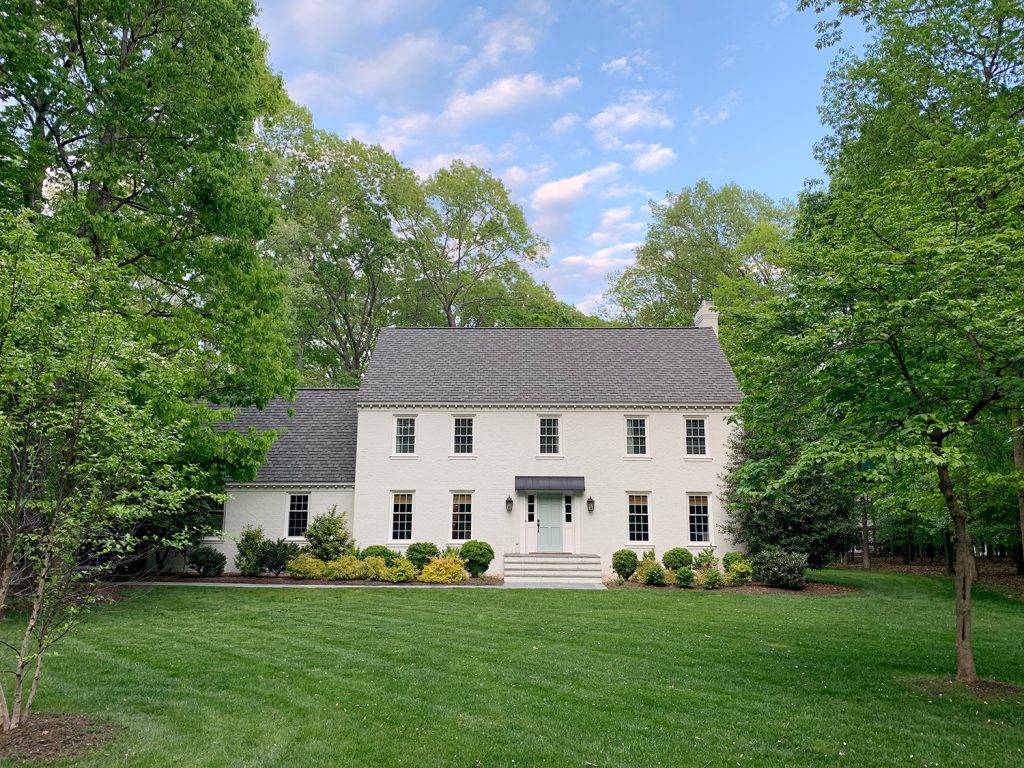
Here in Florida, we’ve spent $0 on lawn services because, well, WE HAVE NO LAWN. It’s a much smaller lot – about 10% of the size of our Richmond house – and it’s primarily just a layer of pine needles, which is common in our neighborhood, along with a lot of native plants (more on that here). So while we have spent some money on new plantings, tree trimming, and fresh pine needles, it’s nowhere close to the ongoing money we had been shelling out to maintain three yards back in Virginia.
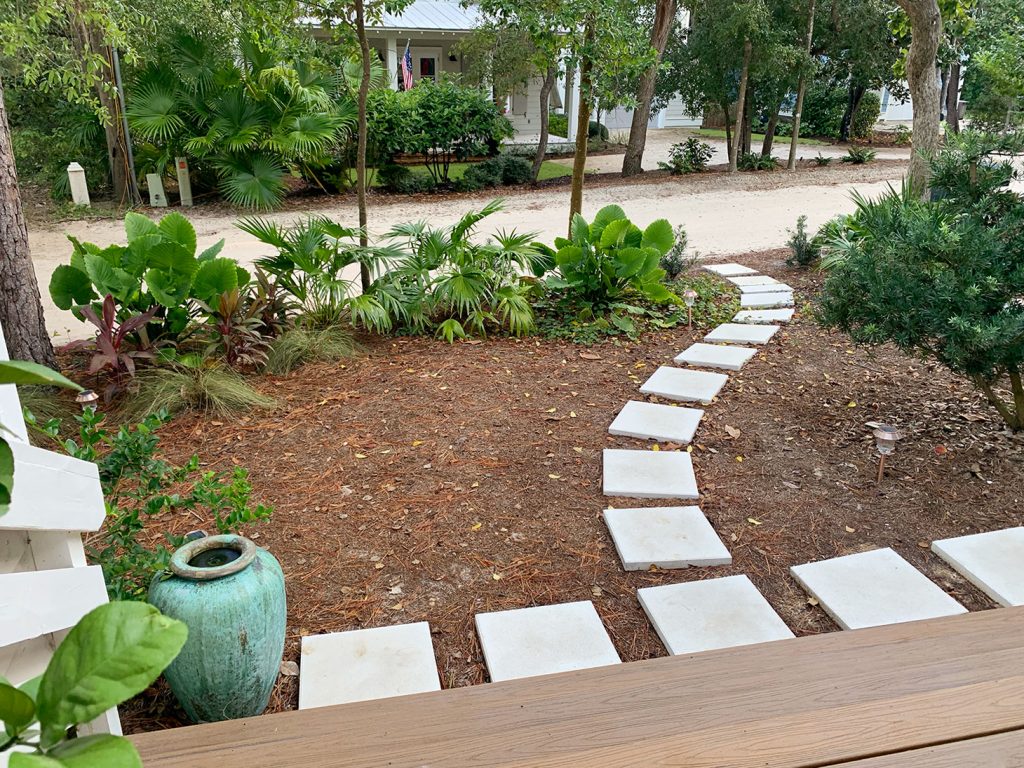
Just to get a rough idea, when you add that $3,750 yard care savings to our utility savings of $7,750, we’re already up to $11,500 in annual savings! So even if you take $1,500 out of that for various start-up yard stuff here (the tree trimming we’ve had done, some plants we added, and some pine straw we thickened in some areas), that’s still a giant difference in money going out the door ($10,000 dollars! every year!!). Plus many of those things won’t be annual expenses (like our initial landscaping and tree-maintenance).
Gas
This one is less about having downsized and more about where we downsized to. As I mentioned above, we sought out a place that was extremely walkable so that we could reach shops, restaurants, parks, and the beach without getting in our car. We lucked out in finding a spot that met that criteria and, apart from big trips to the grocery store (for more bags than we could carry home), or longer trips to a big box store (like Target), we have tons of stuff we can get to on foot or by bike.
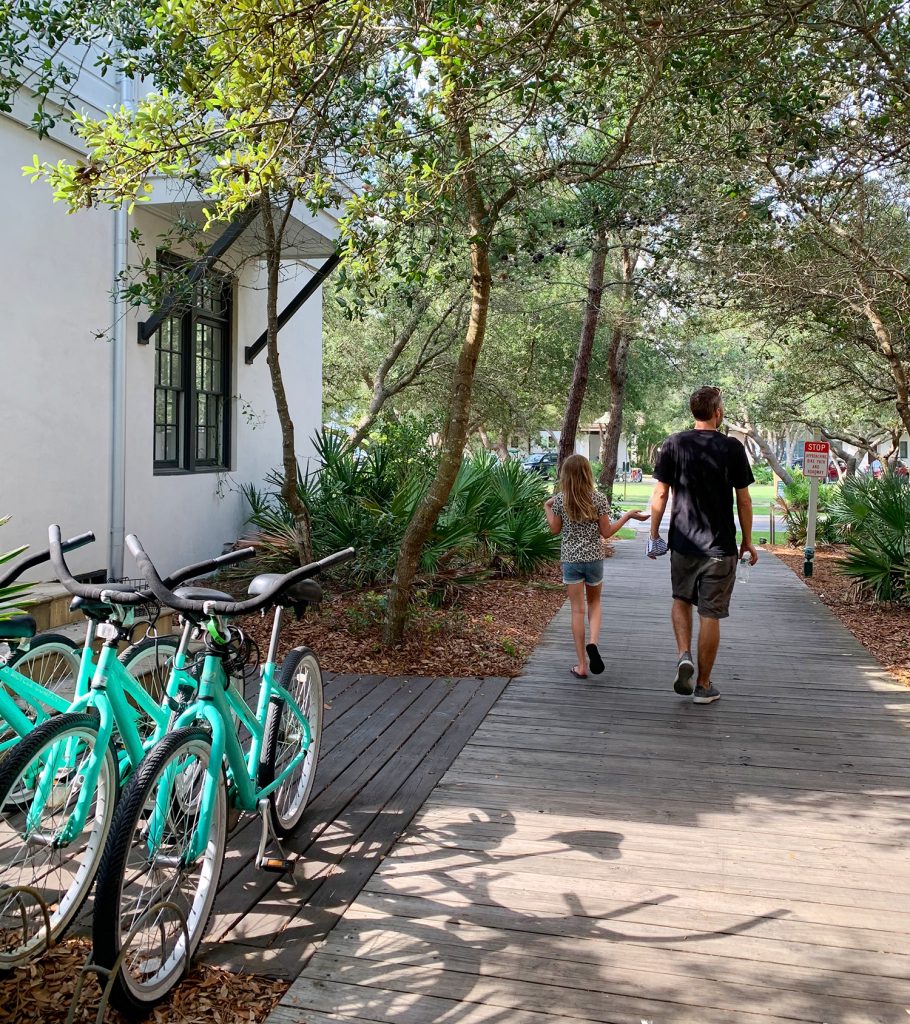
Moving also eliminated the need to drive back-and-forth between our house in Richmond and our beach houses in Cape Charles. Round trip that was about 300 miles, which added up to about 5 hours total – and $30 in tolls each time! During the heaviest parts of our renovations were doing that trip 2 to 4 times per month. So between that and our regular driving around town, we spent over $3,250 in gas & tolls in 2019.
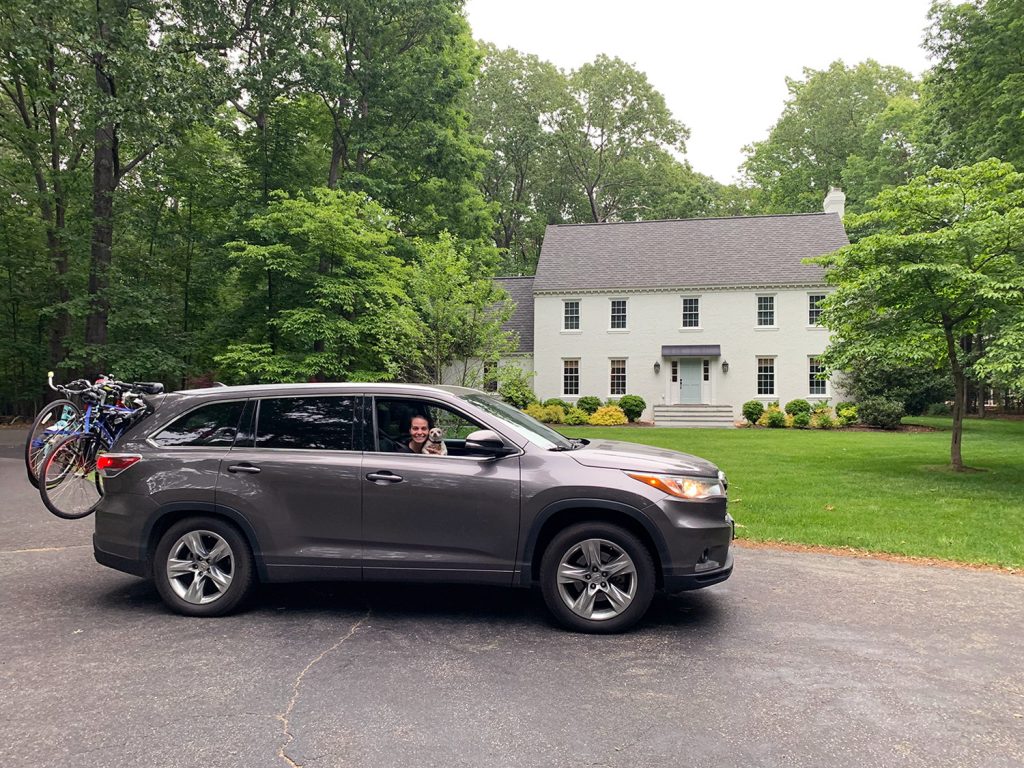
For comparison, in the last six months we’ve only spent $310 on gas. In half a year! That calculates out to around $620 for the year, which leads to an approximate savings of around $2,600 annually. We realize some of this reduced driving is also attributable to the coronavirus, so it’s not a perfect comparison to 2019. I know lots of us have cut back on our normal driving habits because of things like remote working, fewer in-person errands, canceling travel, etc – but whatever the cause, it feels good to go for days without getting into our car. Plus it brings our approximate annual savings to $12,600 across those three categories! That’s $126,000 every ten years!
A Quick Money Disclaimer
I’ll wrap up this money section with a quick disclaimer that this move isn’t saving us money in every aspect of life, since there can be some hidden costs that may actually go up when you move. One thing that has ended up being more expensive here is food (oh how we miss Aldi!) and also our property tax rate. Now, we’re still saving money in overall property tax payments because we made such a dramatic reduction in property, but the savings aren’t as much as if we’d stayed in Virginia. So don’t always assume that just because you’re downsizing that all of your costs – like food, property taxes, HOA fees, transportation costs, etc – will go down, especially if you’re moving to a completely new area.
So, What Are The Challenges Of Downsizing?
Earlier I said there have been two things about downsizing that I’d characterize as challenges, not because they’re insurmountable (they’re not) but simply because they require some active work and attention on an ongoing basis. But like… so do lots of other worthwhile things (kids, relationships, plants, maybe crystals? Don’t you have to talk nicely to those?). So neither of these things are deal-breakers in the least – and they’re both things that you completely adjust to over time, but I’m always a fan of being thorough (hence how long this post has become). So here we go:
#1. Bulk Storage Space Is Nonexistent
When you have just the space that you use and need – it’s great! You don’t spend time heating and cooling a room you don’t use, or money filling it with furniture that you never sit on (like our rarely used dining room in our last house that mostly just became a holding area for stuff we had to bring to the duplex or beach house – or things that we wanted to donate). That being said, in our much smaller home without extra rooms… there is zero space to dump things that you want to deal with later.
I’m not gonna lie. Sometimes you just want a guest room or a garage to put stuff that you want to fix up or donate or sort later, and that isn’t possible here. In our last house I also mentioned that we had a large two-car garage, a huge walk-up attic (seen below – it was GIANT!), as well as a large, detached shed. All of which were full of things at one point. FULL OF THEM.
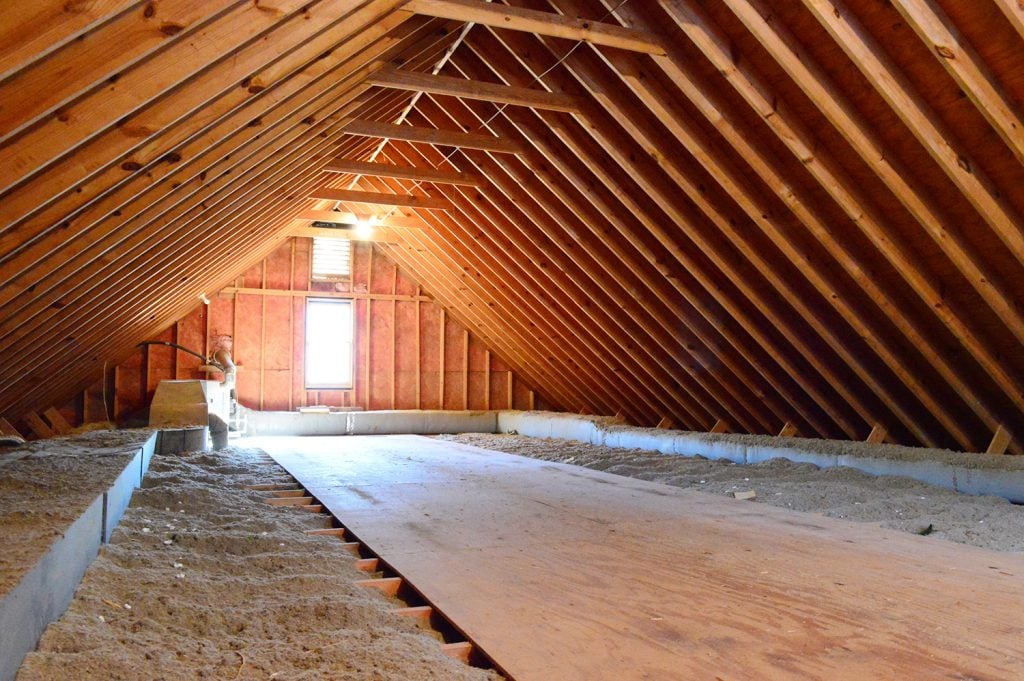
By comparison, our current house has no garage (we got used to not having one at the beach house, which gave us the confidence to forgo one here), no real usable attic space (we have an access door in the ceiling of our laundry closet, but it’s mostly just insulation and some plumbing & heating systems up there), and one small attached shed (seen below).
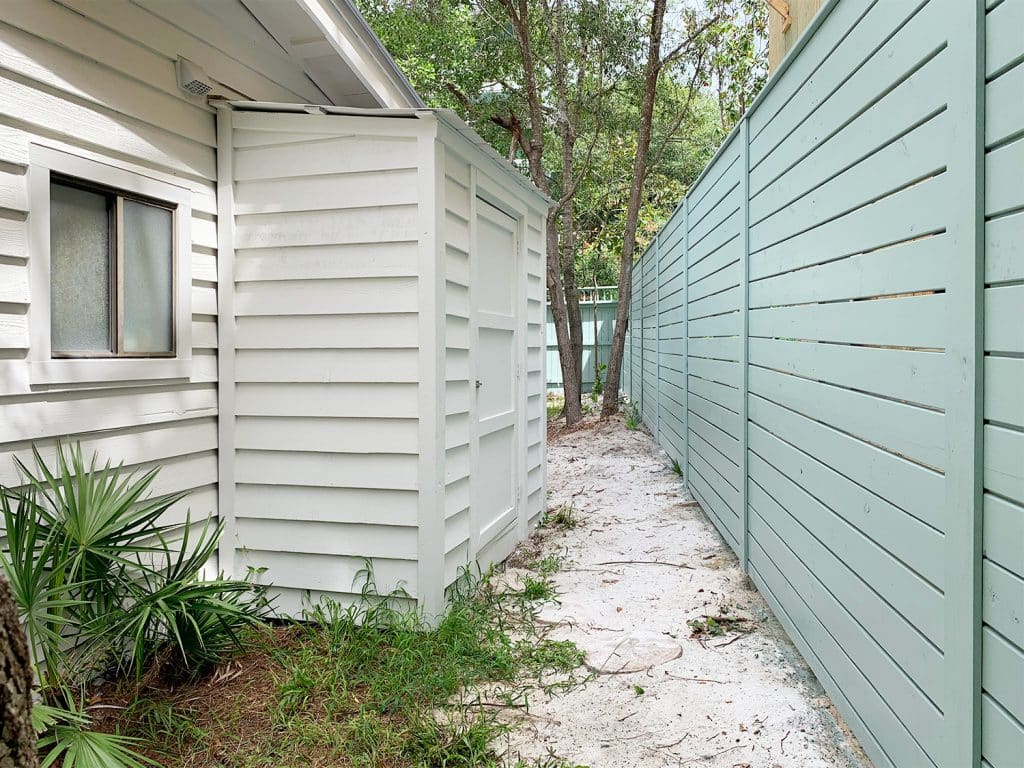
Are we making it work? Emphatic and resolute yes. Was it something to get used to after having all of those aforementioned drop zones for many years? Yup. For sure.
Our downsized number of tools are stored out in the shed for example – no problem! But I don’t think either of us realized how much we used those bulk storage spaces for things like “extra furniture we want to redo” or “leftover project supplies.” Or you know, just space where something could be shoved out of sight when guests were coming over (our garage was often a huge holding area for stuff like that).
Along with using that small shed that you see above for tools, we can also store some leftover project materials in the shed, but we’re forced to very quickly donate or use or return whatever doesn’t fit – which, again, is actually a good thing, but it’s not always the easy/lazy thing. And sometimes after a long sweaty project, it’s nice to get to toss things into the corner of the garage and relax on the couch… which just cannot happen here.
The bright side of this situation is that it has kept us really “honest” about what we buy or bring into the house because it, well, literally has to be brought into the house. In the past, we might’ve scooped up some extraneous furniture or a random decor item that we want to “save” at a yard sale or from a sale rack with a plan to “fix it up eventually” or “find a place for it somewhere.” And that’s how our garage and our attic became a Monica’s Closet of sorts that we were often too embarrassed to show anyone. This picture is tame BTW, because we never had the urge to snap any photos when it was insanely far gone (I wonder why?).
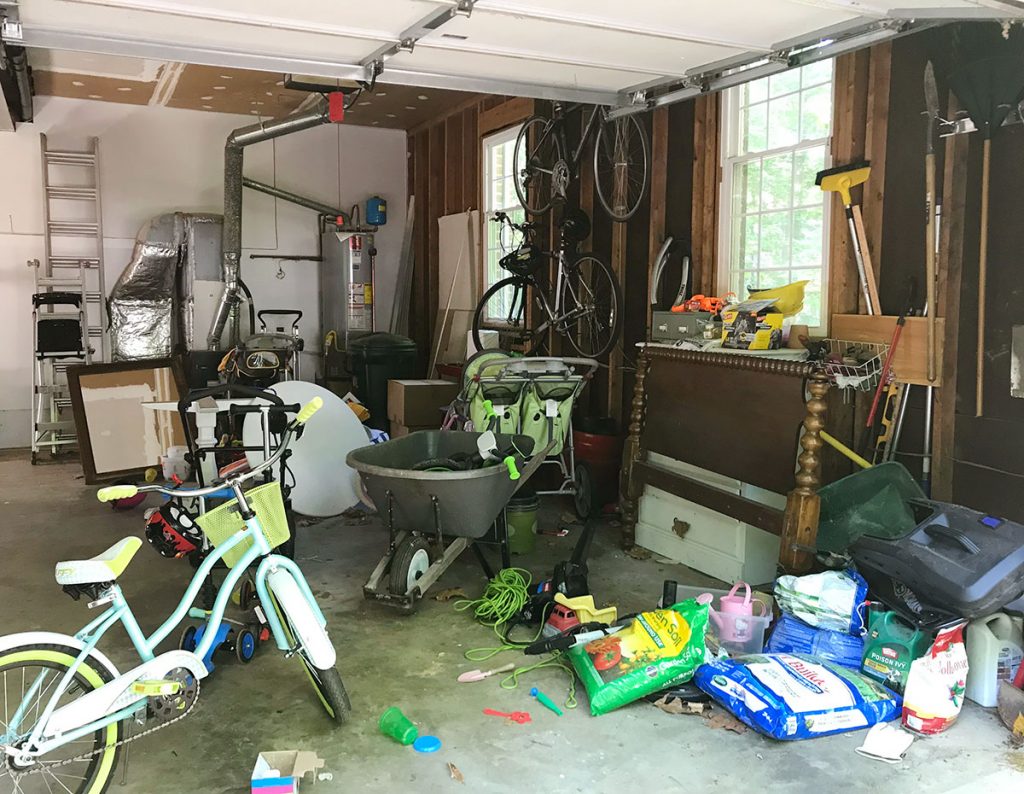
In many ways, we’re really appreciating the required thoughtfulness that this limitation has imposed on us. We’re glad that we don’t have to dedicate weekends to periodic “garage cleanouts” or worry about finding time to organize that yard sale we desperately need to host (sometimes that dragged on for years and we eventually donated everything anyway).
It does mean we’re going to have to be creative when it comes time to, say, take on a big renovation like our kitchen (where are all of the new cabinets or appliances gonna go when they’re delivered?). But we figure that people renovate in all sorts of places, including small city apartments, so we’ll be able to figure something out when the time comes. We already painted our kitchen cabinets, which offset all of those cooking items into other spaces (mainly our bedroom) and it really wasn’t that bad. I like to think that we have way less in this house, so offsetting any of it won’t be as bad, because we’ve pared back so much already.
#2 – It’s Constant Upkeep
This is extremely related to the last challenge we listed, but it bears mentioning that you don’t just downsize once and you’re done. It’s a constant thing that you maintain, often with just a few minutes a day, but it is something to be aware of. It’s a choice you make, and then continue to keep making because you don’t want your house to become overrun with things that get in the way of living life.
It’s a phenomenon that we lovingly call “immediate processing” – something comes into the house, and it needs a place to go. Immediately. Because as we previously mentioned, there’s no “put all the random things to be dealt with later here” zone. The good news is that it doesn’t take tons of time every once in a while (like the old garage clean-up issue) because things never get that bad, but there is truly a necessary upkeep every day to stay on top of clutter and extra stuff. Even a pile of mail that comes in – you’re like… let’s deal with this right now!
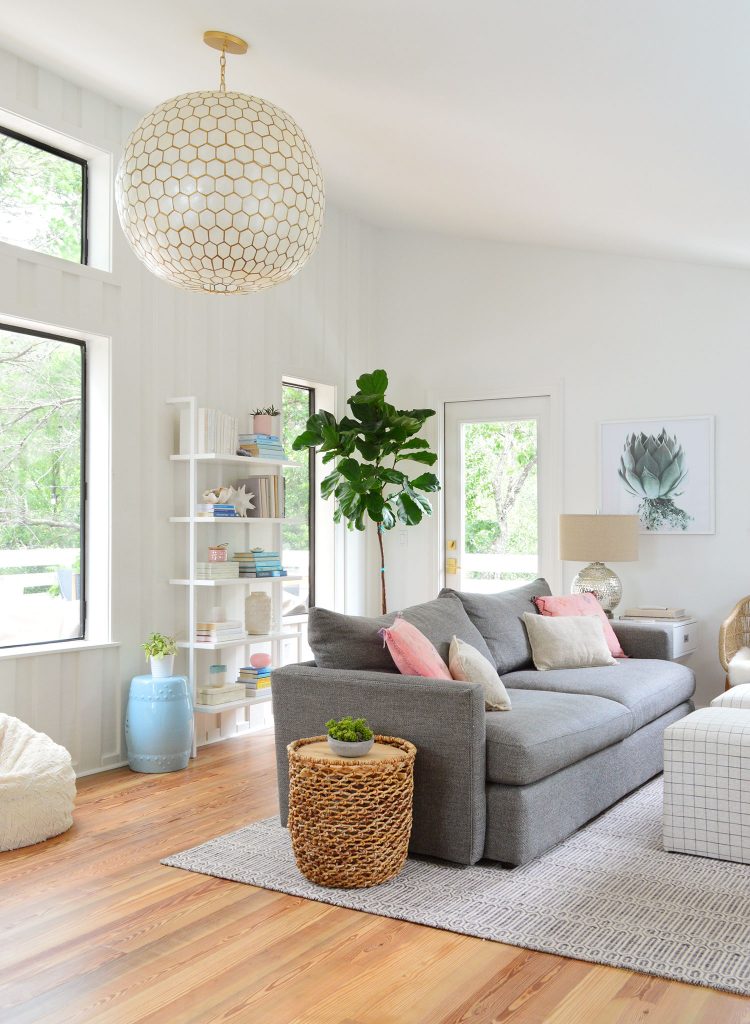
It’s actually a really good money-saving solution – because it heads off those “don’t-really-need-it” purchases, but even on a much smaller scale, it has changed the way we think and do things. We shop for home items (both as big as a piece of furniture or as small as a vase) much less – pretty much unless we have a need for something, we don’t just grab anything because it’s cute – even if it’s just a little vase or a decorative box. Sherry used to slide through the checkout line at Target with things like that all the time in the days of having ten million built-ins.
Even the act of filling this half of our storage cabinet with various unused home accents like vases and bowls and candles prompted Sherry to say “don’t need any more of these like ever.”
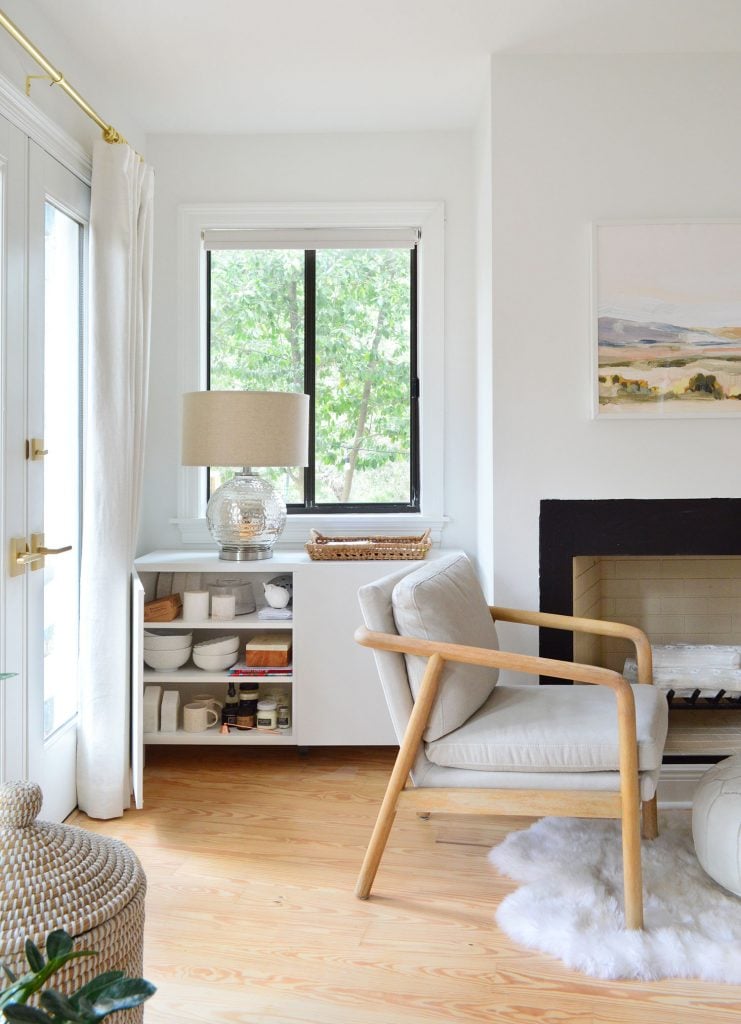
So just seeing your limitations and knowing the amount of space you have for something can be beautifully freeing (and can save you money!) as long as you embrace it instead of trying to keep amassing things and shoving more things into a finite space (which is honestly what got us into the whole we-need-to-downsize mess in the first place).
Another example is that we’ve actually changed our methods for certain things. Whereas our last house’s dining room or garage would fill up with donations over time and then we’d finally get them done once the room was packed to the brim, now we put donations in the back of our car in a bag, and anytime we are out running errands we drop them off instead of ever having them build-up at home. This isn’t really a bad thing at all – in many cases it feels better, but it does involve sort of an “active role” in staying on top of things, versus putting things off for some future date when you actually feel like dealing with them. So it’s just something to be aware of I think.
Ultimately, those two challenges are just a part of adjusting to a completely new way of thinking & living – and in many ways they’re good things – they just take a certain amount of practice, discipline, and upkeep, so I wanted to make sure I mentioned them.

We’re also still planning to add a small detached guest studio in our backyard that can double as a workspace if we ever need a quieter spot than the rest of the house can offer us – plus we’re hoping to add a nice big closet in there for more storage (Sherry has been talking about hanging big white skeletons from our second-floor deck, and that closet might make all of her Halloween-decorating dreams come true).
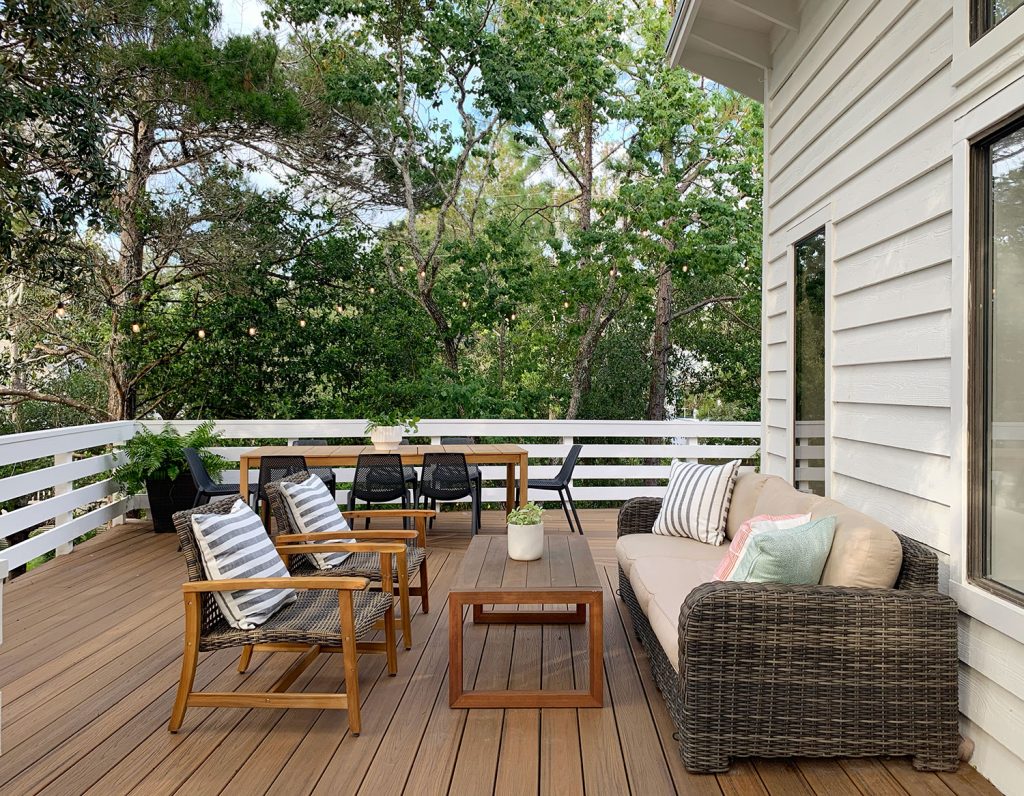
In summary, downsizing has been an overwhelmingly positive change for our family. We know it’s not for everyone, but it feels really good to use and appreciate the space that we have. In our last house we’d go days without entering our dining room, bonus room, guest bedroom, or back porch (except maybe to clean them, ha!). But here there is literally no space that goes to waste.
A year ago I would’ve told you that 1,400 square feet (and one bathroom) was just too small for us (we were targeting more like 1,800 or 1,900 and only entertained this house because the layout felt so spacious) but now we feel like it’s just about perfect. Even in one of the weirdest years any of us have ever experienced (2020).
